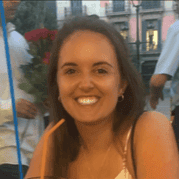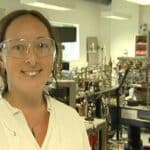Profile
Alex Dickinson-Lomas
-
About Me:
I am a first year PhD student at the University of Birmingham working on finding out more about the effects of radiation on metals used in nuclear reactors. I love rockclimbing, walking and camping! Pronouns: She/her
-
Read more
I have just moved to Birmingham to start my PhD in nuclear materials science. I spent the last year living in the North West of England working as a mechanical engineer for Arup at Sellafield. My idea of a perfect weekend involves rock-climbing, walking and camping in the Lake District or North Wales with friends and I love being out in nature. When I can’t get outdoors I play the piano a lot, get out my guitar and sing loudly…possibly annoying the neighbours!
-
Read more
My PhD research aims to investigate the effects of radiation damage on a selection of materials that are used in nuclear power plants.
I am currently looking at a specific steel used to make reactor pressure vessels. The reactor pressure vessel is the part of a nuclear reactor that contains the nuclear fuel and, in this case, cooling water. It’s about 300 degrees celsius and under high pressure as well as containing a lot of quite nasty radioactive materials. As such it’s essential that the reactor pressure vessel doesn’t burst and being able to predict how the materials the reactor is made of will behave is very useful!
Nuclear Reactors and Radiation
When nuclear fuel in burnt in the reactor it isn’t actually “burning” like coal or oil or gas in a power plant. Nuclear fuel is made from very heavy atoms that will break apart easily as they are very unstable in a process called “nuclear fission”. When this happens the element breaks into smaller atoms and a few tiny particles. They all have lots of kinetic energy which means they move very fast. These small particles are neutrons and are one of the particles that make up the nucleus (centre) of atoms.
The fast moving neutrons created by the unstable elements fly out in all directions and often will hit the pressure vessel sides. They can bash into atoms in the metal and push them out of their positions in the metal so that they start moving and hitting other atoms out of place. This doesn’t change the visible shape of the material but it does change the arrangement of atoms and how they cluster together at a very small scale. Even though the changes are not visible to the naked eye they have a big impact on the mechanical properties of the material or how the material behaves if it is hit or heated or compressed.
What is steel?
Steels are metals that are mostly made from Iron atoms but with some Carbon added along with a range of other elements. Different elements give the steel different properties so are chosen based on what the steel is going to be used for. Almost like a recipe; if you’re making cookies for someone who likes chocolate you might put chocolate chips in them; if you’re designing a steel for a use that requires high strength you would likely add a small amount of Nickel and Manganese. Another example would be stainless steels that we use for cutlery and applications where the metal is going to get wet has lots of Chromium in it as this prevents it from going rusty.
There are so many types of steel and it’s widely used in all sorts of applications in our lives. You’ll see it everywhere you look; lampposts, railway rails, cutlery, nuclear reactor pressure vessels!
My Experiments
In order to predict how steels used for reactor pressure vessels will behave after lots of irradiation (over 40 years, billions of these particles will be hitting the metal and causing damage) I am taking small samples of steel and alloys and irradiating them and then using microscopes to try to obtain images of what is changing in the material. I’m also going to be testing the hardness of the material, by measuring the force required to create a tiny hole in the material, before and after irradiation so that the effects on mechanical properties can be compared. This will give us information about how we can expect the properties of reactor pressure vessels to change. If we can prove they can operate safely for longer than expected then the lifetime of nuclear power plants can be extended. As these power plants are very expensive to build and large construction projects have a big impact on the environment making the ones we have already work for longer would be a great benefit.
-
My Typical Day:
I get up and head into the university. Often I will spend some time in the lab preparing metal samples for experiments. This involves a lot of polishing to make sure that the metals are very flat. I sometimes go to a particle accelerator to fire tiny particles at my metal samples to see what happens to them. The changes that I’m looking for cannot be seen with the naked eye so I spend a lot of time using powerful microscopes to zoom in and spot changes to how different sections of the metal are arranged. Then I end up reading about what other scientists have done to work out what is going on and what ideas I could use to explain what has been happening in my materials. On an untypical day I might be abroad at a large scientific facility using instruments to analyse the small structures within my material, staying up all night checking the machines are running smoothly and looking at the data coming through.
-
Read more
Every day as a PhD student is different so I’ve included some of the more practical elements of my work. On a normal day I’ll probably spend half my day in the lab and half doing some data analysis and reading! I also have a few teaching jobs and am helping undergraduates carry out their research projects so I often have calls or labs with them too.
9:00 Head to the lab! My research group has a small sample preparation lab where we store our samples and have equipment for cutting and polishing them. Why all this polishing?! Well…in order to get good microscope images that reveal the structure of metals you need a very clean, very flat surface. Other wise your images will either be just a mess of bumps that are not related to the arrangement of the atoms in the metal (what we call the microstructure) or there will be fluff and dirt in your image. This process can take some time as you have to polish the metal until it looks like a mirror! If you drop it in the process or accidentally scratch the surface…you’ve got to go back and redo it.
11:00 Not every day but each week our research group have a meeting where we share our progress from the week. This is a great chance to see what other people have been up to and to get some feedback on your work/ show of any nice work you’ve done!
LUNCH; I always get out for a stroll at lunchtime; our campus has plenty of beautiful spaces to wander about and I find I need a bit of fresh air before…
13:00 It’s Microscopy time! Of an afternoon, researchers from my group can often be found in small rooms around the department looking at very very small sections of very small samples of all sorts of materials to learn more about what is going on. Here is a picture of the Scanning Electron Microscope I was recently trained to use. The tubes coming out of the back are all different types of detector. The microscope works by firing electrons at a material and detecting any electrons or X-rays that are scattered or emitted from the sample. This gives an image of the surface and other information that can be used to find out what elements are present in the sample.
17:00 Generally I manage to be off home around now but on an VERY untypical day I could be…
ABROAD! Part of my project involves using Small Angle Neutron Scattering; a technique of materials analysis that requires very specialised instruments and…a nuclear reactor…so to do these experiments scientists have to travel to special facilities to use their equipment. When you go, sometimes measurements need running overnight which can be pretty challenging! Imagine staying up all night but also having to make sure you’re keeping the machines on track and analysing data! Here are a couple of pictures from the first experiment I went on before my project in Grenoble, France.
-
What I'd do with the prize money:
Develop a set of materials science related workshops, demonstrations and resources that link to the national curriculum so that students can learn about this field in relation to both their studies and the importance of materials in everyday life.
-
Education:
Aylesbury High School and the University of Birmingham
-
Qualifications:
GCSEs; English, Maths, Double Science, French, Italian, Music, Food Tech, History
A Levels: Chemistry, Physics, Maths, Further Maths and AS Politics
BSc in Nuclear Science and Materials
MSc in Nuclear Decommissioning and Waste Management
-
Work History:
Graduate Mechanical Engineer, Arup.
Thesis Student, Cavendish Nuclear, Sellafield.
Arup Whitehaven, Cumbria.
Piano Teacher . -
My Interview
-
How would you describe yourself in 3 words?
Enthusiastic, curious, determined.
What did you want to be after you left school?
I wanted to be a nuclear engineer.
Were you ever in trouble at school?
Not often...sometimes for being a bit chatty...a lot chatty!
Who is your favourite singer or band?
Florence and the Machine
What's your favourite food?
Eggs on toast.
If you had 3 wishes for yourself what would they be? - be honest!
1. Birmingham had some very dramatic and tall mountains nearby to explore! 2. I didn't have Coeliac disease...so I could eat nice freshly baked baguettes! 3. I could do magic.
-






